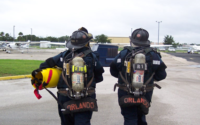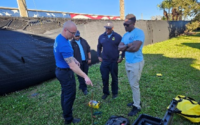The Biological Weapon Threat- (Part 1) Defining the Problem
Kevin Ryan

Biological Weapons continue to be a threat to jurisdictions across the USA. The use of these weapons can be used on an international or domestic basis. Biological weapons form a subset of a larger class of weapons sometimes referred to as unconventional weapons or weapons of mass destruction, which also includes chemical, nuclear and radiological weapons. The use of biological agents is a grave concern, and the risk of using these agents in a terrorist attack is thought to be increasing.
Bioweapons have been in use since the dawn of civilization. In the year 1155. Emperor Barbarossa poisoned water wells with human bodies in Tortona, Italy. Moving forward to the World War II era, the Japanese had unit 731 which used human subjects to conduct bioweapons testing. A more recent

example was the Anthrax attacks of 2001. Several anthrax letters were sent to various VIP’s including Senator Tom Daschle. The study and use of Bioweapons has been well documented over the years and can be easily found when doing research via internet or printed books(nih.gov).
A responder in a small community might think that this problem could not affect them in any way. The reality of it is that any community, small or large, may be confronted with this problem. Information on these types of weapons can be found anywhere on the internet. A 70-year-old woman in Shelburne VT attempted to use Ricin at an upscale senior village in 2017. She stated she wanted to test the effectiveness of her concoction by putting it in the food and drink of other residents. The news article can be found here: https://www.necn.com/news/local/vermont/vermont-retirement-community-ricin-incident-arrest/23107/. Shelburne VT is a town of approximately 7700 people. A smaller jurisdiction on the local level probably does not have the resources to handle an incident of this nature. County, State and Federal resources would have to be called in to assist. Resource assistance could include law enforcement for investigation and the health department to ascertain the extent of the contamination.
What defines a biological attack? According to dhs.gov, A biological attack is the intentional release of a pathogen (disease causing agent) or biotoxin (poisonous substance produced by a living organism) against humans, plants, or animals. An attack against people could be used to cause illness, death, fear, societal disruption, and economic damage. An attack on agricultural plants and animals would primarily cause economic damage, loss of confidence in the food supply, and possible loss of life.
DHS also distinguishes between 2 types of biological agents:
1. Transmissible agents that spread from person to person (e.g., smallpox, Ebola) or animal to animal (e.g., foot and mouth disease).
2. Agents that may cause adverse effects in exposed individuals but that do not make those individuals contagious to others (e.g., anthrax, botulinum toxin).
The CDC further defines 3 categories of Bio Agents:
Category A
The U.S. public health system and primary healthcare providers must be prepared to address various biological agents, including pathogens that are rarely seen in the United States. High-priority agents include organisms that pose a risk to national security because they
-can be easily disseminated or transmitted from person to person.
-result in high mortality rates and have the potential for major public health impact.
-might cause public panic and social disruption; and
-require special action for public health preparedness.
-Ex-anthrax, plague, smallpox
Category B
Second highest priority agents include those that:
- are moderately easy to disseminate.
- result in moderate morbidity rates and low mortality rates; and
- require specific enhancements of CDC’s diagnostic capacity and enhanced disease surveillance.
Ex- glanders, Q fever, ricin toxin
Category C
Third highest priority agents include emerging pathogens that could be engineered for mass dissemination in the future because of
- availability.
- ease of production and dissemination; and
- potential for high morbidity and mortality rates and major health impact.
Ex- hantavirus, nipah virus
In addition, the CDC and USDA maintain the Federal select agent program. Here is the FSAP description from the website:
The Federal Select Agent Program (FSAP) regulates the possession, use, and transfer of biological select agents and toxins that have the potential to pose a severe threat to public, animal, or plant health. Examples of select agents and toxins include the organisms that cause anthrax, smallpox, foot-and-mouth disease, as well as the toxin ricin.
Program overview link:
https://www.selectagents.gov/overview/index.htm
Select Agent list link:
https://www.selectagents.gov/sat/index.htm
BioSafety Lab Levels also play a part in the handling and use of these agents. The levels 1-4 are based on the agents being used in the lab and the necessary engineering controls that need to be in place for safe handling. The CDC has put together a nice infographic to explain the various levels. It can be viewed here: https://www.cdc.gov/cpr/infographics/biosafety.htm. More information on the lab levels and descriptions can be found here: https://consteril.com/biosafety-levels-difference/.
Bio warfare agents are broken down into pathogens and toxins. Here is the definition of each:
Pathogens- an organism causing disease to its host, with the severity of the disease symptoms referred to as virulence. Pathogens can be viruses or bacteria. Microscopic single-celled organisms lacking a distinct nucleus are known as bacteria (Merriam Webster Dictionary). A virus is an infectious agent of small size and simple composition that can multiply only in living cells of animals, plants, or bacteria (Britannica.com). The main difference between the two is that viruses need a host of living cells to replicate. Once in the cell, viruses take over the cell mechanisms to reproduce the virus. Bacteria, unlike viruses, do not need a host and can live inside or outside the body. Flu is a virus. The virus needs to invade the host cells to replicate. The body’s defense mechanism is to increase body temperature. The increased temperature is an attempt to make the environment inhospitable for the invading virus. Various other symptoms appear when a body is under attack from a virus. Anthrax is an example of a bacteria. Bacillus anthracis is the
causative agent for disease-causing bacteria. Each pathogen utilizes different mechanisms to invade a foreign body. There are bacteria(anthrax) and viruses (smallpox) that are listed as Category A agents by the CDC.

Toxins- substances created by plants and animals that are poisonous (toxic) to humans. Toxins may also include some medicines that are helpful in small doses, but poisonous in copious amounts (Medline Plus Medical Encyclopedia). Toxins can be derived from bacteria, fungi, algae, and plants. These types are described by the CDC Lab Response to Toxins infographic here: https://www.cdc.gov/biomonitoring/pdf/Toxins_Fact_Sheet.pdf.
Each jurisdiction should preplan and know how to get their samples from emergency incidents into the Lab Response Network (LRN). The LRN ultimately can get samples to the CDC for evaluation. The state lab for Maryland is in East Baltimore at the Johns Hopkins Hospital complex. Samples from incidents can be sent to the lab through various agencies that are a contact point for the LRN. Local hazmat teams and responders need to know how to access this vital link in a possible bio incident.
Part I of this series on Biological Weapons covered some history, defined a bio attack, listed DHS and CDC categories. Bio Safety Lab levels as well as the difference between pathogens and toxins were discussed. Part II will look at recognition of a biological attack.



